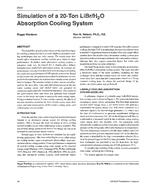Description
The possibility of using solar energy as the main heat input for cooling systems has led to several studies of available cooling technologies that use solar energy. The results show that double-effect absorption cooling systems give relatively high performance. To further study absorption cooling systems, a computer code was developed for a double-effect lithium bromide/water (LiBr/H2O) absorption system. To evaluate the performance, two objective functions were developed including the coefficient of performance (COP) and the system cost. Based on the system cost, an optimisation to find the minimum cost was performed to determine the nominal heat transfer areas of each heat exchanger. The nominal values of other system variables, such as the mass flow rates and inlet temperatures of the hot water, cooling water, and chilled water, are specified as commonly used values for commercial machines. The results of the optimisation show that there are optimum heat transfer areas. In this study, hot water is used as the main energy input. Using a constant load of 20 tons cooling capacity, the effects of various variables including the heat transfer areas, mass flow rates, and inlet temperatures of hot water, cooling water, and chilled water are presented.
KEYWORDS: year 1996, calculating, lithium bromide, water, absorption refrigeration, solar energy, cooling, performance, coefficient of performance, costs, optimisation, heat flow, heat exchangers, flow rate, temperature, cooling load
Citation: ASHRAE Trans. 1996, vol.102, part 1, paper number 3942, 96-103, 10 figs., 1 tab., refs.
Product Details
- Published:
- 1996
- File Size:
- 1 file , 860 KB
- Product Code(s):
- D-16518




